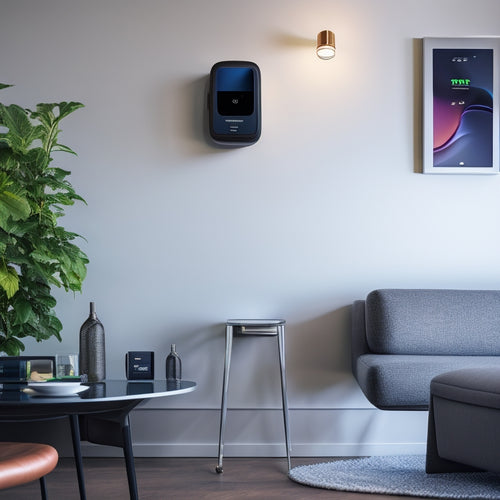
USPS Charges Ahead With Electric Vehicle Revolution
Share
The United States Postal Service (USPS) is driving forward with its electric vehicle (EV) revolution, investing approximately $10 billion in a new fleet featuring next-generation electric vehicles and supporting infrastructure. The initiative aims to reduce the organization's environmental impact and shift towards a more sustainable future. Key milestones include the deployment of over 400 operational charging stations within the next three years and the development of a robust charging infrastructure. As USPS navigates the challenges of fleet electrification, its commitment to sustainability will be essential in achieving a majority electric fleet, and Discover how this vision takes shape.
Key Takeaways
• USPS aims to deploy over 400 EV charging stations within the next three years, facilitating widespread EV adoption.
• The organization is investing approximately $10 billion in a new fleet, allocating a significant portion to electric vehicles and infrastructure.
• The shift to electric vehicles is crucial for USPS's sustainability goals, expecting a significant reduction in greenhouse gas emissions by 2030.
• New electric delivery trucks will have nearly three times the cargo capacity and can travel at least 70 miles on a single charge.
• USPS plans to achieve a majority electric fleet, exceeding federal fleet electrification requirements, with industry partnerships driving innovation and cost reduction.
USPS Electric Vehicle Initiatives
The United States Postal Service (USPS) has initiated an ambitious electric vehicle (EV) initiative, revealing its first EV charging stations at the South Atlanta Sorting and Delivering Center, with plans to deploy 100 operational charging stations by year-end and over 400 within the next three years.
This all-encompassing effort marks a significant milestone in USPS's commitment to electrifying its fleet. The development of a robust charging infrastructure is vital to support the integration of next-gen vehicles, enabling seamless operations and reducing range anxiety.
As USPS commences on this transformative journey, the establishment of a thorough charging network will be instrumental in facilitating the widespread adoption of electric vehicles, ultimately paving the way for a more sustainable and environmentally friendly fleet.
Fleet Transformation and Investment
Investing approximately $10 billion in a new fleet, USPS is poised to revolutionize its delivery operations, with a significant portion allocated to electric vehicles and supporting infrastructure. This investment will have numerous benefits, including improved efficiency, reduced costs, and a decreased carbon footprint.
| Investment Benefits | Fleet Modernization | Expected Outcomes |
|---|---|---|
| Reduced maintenance costs | Upgraded safety features | Increased efficiency |
| Improved fuel efficiency | Increased cargo capacity | Lower greenhouse gas emissions |
| Enhanced package delivery | Modernized infrastructure | Reduced operational costs |
The new fleet will feature next-generation electric vehicles, which will increase efficiency and reduce costs. With a focus on sustainability, USPS is committed to making its fleet more environmentally friendly. The investment in electric vehicles and supporting infrastructure will have long-term benefits for the environment and the organization.
Environmental Impact and Sustainability
By shifting to electric vehicles, USPS expects a significant reduction in greenhouse gas emissions, with an expected decrease of 3.9 million metric tons by 2030. This change is vital for the organization's sustainability goals, as it aims to make its fleet more sustainable with a majority of electric vehicles.
The new electric delivery trucks will have nearly three times the cargo capacity of current vehicles, enhancing package delivery efficiency. With electric vehicles expected to travel at least 70 miles on a single charge, USPS is poised to achieve substantial carbon reduction and energy efficiency.
Overcoming Legal Challenges Ahead
Despite its ambitious plans for electrification, USPS faces legal hurdles that could potentially slow its shift to a more sustainable fleet. The postal service must navigate ongoing court battles and address concerns over environmental reviews.
- A lawsuit filed against USPS aims to prevent further action until a more in-depth environmental review is conducted.
- The NRDC and UAW previously dropped a lawsuit over USPS's original gas-powered fleet plans.
- The final supplemental environmental impact statement was completed in June 2023.
USPS is exploring the feasibility of achieving 100% electrification for the delivery fleet. The White House has taken note of USPS's fleet plans, which exceed President Biden's federal fleet electrification requirement.
The Future of USPS Fleet Electrification
As the United States Postal Service (USPS) continues to forge ahead with its electric vehicle initiatives, the future of its fleet electrification efforts hinges on successfully managing the complex interplay of technological advancements, infrastructure development, and strategic planning.
To achieve its goal of a majority electric fleet, USPS will need to employ future strategies that prioritize scalability, flexibility, and adaptability. This may involve fostering industry partnerships to drive innovation and reduce costs.
Challenges in Transitioning to Sustainability
One significant hurdle in the USPS's pursuit of a sustainable fleet lies in the sheer scale of its operations, which necessitates a massive overhaul of its existing infrastructure and logistics. This transformation poses numerous challenges, including:
-
Aging vehicles requiring increased maintenance costs
-
Limited charging infrastructure in rural areas
-
Higher upfront costs of electric vehicles
-
Complexity in managing charging schedules and routes
-
Need for thorough total ownership cost analysis to justify electric vehicle purchases
These obstacles underscore the complexity of the USPS's sustainability goals. As the organization works towards a majority electric fleet, it must carefully navigate these challenges to ensure a seamless and cost-effective shift.
A Sustainable Fleet for the Future
The United States Postal Service's commitment to a sustainable fleet for the future is driven by its ambitious goal of electrifying the majority of its next-generation fleet, which will significantly reduce greenhouse gas emissions and operating costs.
This shift towards a green technology-based fleet will not only benefit the environment but also contribute to the USPS's long-term financial sustainability. By investing in renewable energy-powered vehicles, the USPS is taking a significant step towards reducing its carbon footprint.
With plans to purchase 66,000 electric vehicles over the next five years, the USPS is poised to become a leader in sustainable fleet management. This commitment to a sustainable fleet for the future will have far-reaching benefits for the environment, the USPS, and its customers.
Frequently Asked Questions
Will All USPS Electric Vehicles Be Manufactured by Oshkosh Defense?
"Rome wasn't built in a day," and neither will USPS's electric fleet. While Oshkosh Defense secured a significant government contract, there's no indication they'll be the sole manufacturer. Production timelines and future contracts may introduce other players, diversifying the electric vehicle supply chain.
Are Electric Vehicle Charging Stations Only for USPS Use?
The electric vehicle charging stations installed by USPS will not be exclusive to USPS use, as they can be accessed by the public, promoting widespread adoption and leveraging public incentives to drive sustainable transportation.
Will the Increased Cargo Space in Electric Vehicles Reduce Delivery Times?
"Ha! Think again if you thought more cargo space means faster delivery - it's about optimized routes and ergonomic vehicle design, not just increased capacity, to truly reduce delivery times."
Can the Public Use USPS Electric Vehicle Charging Stations?
Regarding public access to USPS electric vehicle charging stations, currently, there is no explicit indication of public access or station availability for non-USPS users, as the primary focus is on supporting the USPS fleet transformation.
Will USPS Electric Vehicles Have Advanced Safety Features?
As the postal service enters into its electric vehicle revolution, it's likely that advanced safety features will be integrated, including collision avoidance, blindspot detection, and lane departure warning systems, mirroring the industry's shift towards enhanced safety standards.
Related Posts
-

7 Best EV Battery Health Trackers for Homeowners
You can maximize your electric vehicle's performance and lifespan by leveraging advanced battery health trackers that...
-

10 Best Energy-Efficient External Hard Drives for Sustainable Offices
When it comes to sustainable offices, you need external hard drives that balance data storage needs with energy effic...
-

7 Top HEPA Filters for Green Building Projects
You need a reliable HEPA filter for your green building project that aligns with your sustainable goals and guarantee...


